The Difference Between Gas Inserts and Gas Logs
So you think you have a gas fireplace? It is fairly simple to figure out whether your fireplace burns gas or not. First, there is not an empty space for logs and fire-building in your firebox. Instead, you’ll find logs—usually ceramic. Your system will be connected to a gas line of some kind and will have an ignitor and pilot light. This is a gas fireplace. What type of gas fireplace you have can be slightly more difficult to figure out. If you don’t have your owner’s manual, it is important to determine what type of system you have. Using the system according to its design is important for safety and efficiency as well as convenience.
 Types of Gas Appliances
Types of Gas Appliances
Gas is a fuel type that is always growing in popularity due to its convenience and versatility as well as efficiency and cost. You may be able to use gas in any room in your house, but your venting and your space will determine what type of appliance is best for you.
- Gas Stoves – Like all other types of stoves, a gas stove can be freestanding anywhere in a room. It can fit into a corner, in an existing firebox, on any story, and in any sized home or apartment. A professional can install a gas stove anywhere using appropriate refractory materials.
- Gas Fireplaces – A gas fireplace can be accomplished by installing a gas log set into an existing firebox, or installing a manufactured insert into a wall or firebox. Your professional chimney sweep can help you determine which type of gas fireplace is best for your home, your style, and your need.
Gas Inserts V. Gas Logs
Perhaps you don’t have the space for a gas stove or you simply like the appeal of a fireplace more, you can get the same benefits from a gas log set or insert. If your gas fireplace is set into a wall or hearth, it is likely one or the other. If it has glass doors, ceramic logs, and no visible ash or creosote residue, you’re looking at a gas insert or gas log set—not a wood-burning fireplace.
Identifying a Gas Insert
A gas insert is a closed unit, like a stove, but looks like a fireplace. It is retrofitted into an existing firebox or installed directly into a wall. A gas insert may have ventilation that is hidden. It may vent through the ceiling or wall and many draw air the same way, leaving the air in your home undisturbed. A direct vent insert, for instance, has a pipe that draws air in from the outside to help the fire burn. Inside this pipe is the actual flue that vents the toxins from the fire. This allows there to be only on vent and means the air inside the home is continuously cycled and heated and deposited back into the home.
- A gas insert is retrofitted into a traditional masonry fireplace
- A gas insert produces radiant heat and warm air
- A gas insert will often have doors or a closed glass front
- Logs in a gas insert are sometimes rearrangeable (for aesthetics)
- Gas inserts are made with a metal firebox
Identifying a Gas Log Set
A gas log set is convenient for people who would like a fireplace but don’t need it to produce a lot of heat. Gas logs use gas for fuel, but don’t cycle air from the room and continuously heat it. Some gas log sets feature detailed ceramic logs and others are very simple. Some require a vent and others do not. Gas log sets are cheaper than inserts and ideal for converting from a wood-burning fireplace without a lot of costs.
- A gas log set will sometimes have a blue flame
- Gas logs are removable (for cleaning) but have a specific order for optimal use
- Gas logs require an existing fireplace
- Gas logs are usually installed in a masonry fireplace with no special wall or floors
Know Your System for Safety
Part of knowing your system is identifying what type you have but also locating the model number so that you can use it properly. Generally, gas appliance work in the same way—using gas and an ignitor the fire lights, and continuous fuel and airflow allows it to maintain a flame. The toxins produced by the fire are then vented out a flue or if it is a vent-free log set or insert it will require no ventilation and all the heat and moisture from the fire comes into the living space. Using a vented fireplace with no vent is dangerous and can cause permanent injury or death.
If you’re not sure whether your fireplace should be vented or not, it is imperative that you locate the model number and user guide before lighting it. If you cannot locate your model number or user manual, a professional can do this during a standard gas service appointment.
Schedule a fireplace maintenance appointment with Billy Sweet Chimney Sweep and we can help you identify your fireplace. When one of our fireplace experts complete the job, you can rest assured you’re using your fireplace properly and safely.
Call us today at 617-469-4528 if you live in and around Boston.
Call our North Shore number: 781-593-2333.
Call our Portland area number: 207-773-7933.
